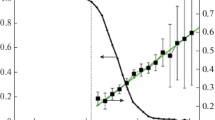Abstract
Statistical analysis of the results of molecular dynamics (MD) calculation of gas-phase “self-assembling” of nanoclusters during metal vapor condensation revealed the laws of energy transfer between metallic clusters and inert gas atoms. A model is proposed to determine the parameters of heat exchange between clusters and the environment at the initial stage of condensation. This model is based on averaged MD data on the interaction between small clusters and argon atoms. The parameters that can be used to transfer information from MD to a macroscopic condensation model are numerically determined. The results obtained can be used to describe nucleation to predict a nanoparticle size distribution in the production of metallic powders.







Similar content being viewed by others
REFERENCES
A. I. Gusev, “Nanomaterials, Nanostructures, Nanotechnologies (Fizmatlit, Moscow, 2007).
I. V. Frishberg, L. I. Kvater, B. P. Kuz’min, and S. V. Gribovskii, Gas-Phase Method for Producing Powders (Nauka, Moscow, 1978).
A. M. Ivanov, A. V. Khitrin, and V. V. Bryukhanov, “Synthesis of copper, brass, and silver nanoparticles by laser ablation and an optical study of the formed structures,” Estestv. Tekhnich. Nauki, No. 5, 26 (2011).
E. Yu. Loktionov, A. V. Ovchinnikov, Yu. S. Protasov, Yu. Yu. Protasov, and D. S. Sitnikov, “Gas–plasma flows under femtosecond laser ablation for metals in vacuum,” High Temperature 52, 132–134 (2014).
V. V. Domashenko, M. I. Lerner, and S. G. Psakh’e, “Synthesis of composite metal nanoparticles by the electric explosion of conductors,” Zh. Strukt. Khim. 45, 112 (2004).
H. Yang, E. Goudeli, and C. J. Hogan, “Condensation and dissociation rates for gas phase metal clusters from molecular dynamics trajectory calculations,” J. Chem. Phys. 148, 164304 (2018).
A. G. Vorontsov, A. E. Korenchenko, and B. R. Gel’chin-skii, “Analysis of stability of small metallic clusters during metal vapor condensation,” High Temperature 57, 368–371 (2019).
D. Yu. Lenev and G. E. Norman, “Molecular modeling of thermal accommodation of argon atoms on clusters of iron atoms,” High Temperature 57 (4), 490–497 (2019).
I. V. Chepkasov, Y. Y. Gafner, and S. L. Gafner, “Synthesis of Cu nanoparticles by condensation from the gas phase,” Phase Transitions 90 (6), 590–597 (2017).
B. M. Smirnov, “Processes involving clusters and small particles in a buffer gas,” Phys. Usp. 54, 691–721 (2011).
S. P. Fisenko, “Microstructure of the supersaturation field in homogeneous nucleation in vapor–gas mixture,” The Russian J. Appl. Phys. 58 (5), 658–663 (2013).
A. Yu. Varaksin, “Clusterization of particles in turbulent and vortex two-phase flows,” High Temperature 52, 752–769 (2014).
A. Yu. Varaksin, “Collision of particles and droplets in turbulent two-phase flows,” High Temperature 57, 555–572 (2019).
A. E. Korenchenko and B. R. Gel’chinskii, “Mathematical simulation of the formation of metallic nanoparticles during the condensation of molten metal vapors,” Russ. Metall. (Metally), No. 8, 723–728 (2011).
A. E. Korenchenko, A. G. Vorontsov, B. R. Gel’chinskii, and A. A. Zhukova, “Determination of small copper clusters based on simulation of the process of gas phase condensation,” High Temperature 57 (2), 275–278 (2019).
A. E. Korenchenko, A. G. Vorontsov, B. R. Gel’chinskii, and G. P. Sannikov, “Statistical analysis of dimer formation in supersaturated metal vapor based on molecular dynamics simulation, Physica A 496, 147–155 (2018).
A. E. Korenchenko, A. G. Vorontsov, and A. A. Zhukova, “Macroscopic model of copper vapor condensation in an inert gas atmosphere,” Russ. Metall. (Metally), No. 6, 601–609 (2019).
S. Plimpton, “Fast parallel algorithms for short-range molecular dynamics,” J. Comput. Phys. 117, 1–19 (1995).
S. M. Foiles, M. I. Baskes, and M. S. Daw, “Embedded-atom-method functions for the fcc metals Cu, Ag, Au, Ni, Pd, Pt, and their alloys,” Phys. Rev. B 33, 7983–7991 (1986).
M. D. Morse, “Clusters of transition-metal atoms,” Chem. Revs. 86, 1049–1109 (1986).
Funding
This work was supported by the Russian Foundation for Basic Research, project nos. 20-03-00527 A and 20-03-00370 A.
Author information
Authors and Affiliations
Corresponding author
Additional information
Translated by K. Shakhlevich
Rights and permissions
About this article
Cite this article
Korenchenko, A.E., Gel’chinskii, B.R., Vorontsov, A.G. et al. Statistical Model for the Energy Exchange during Copper Vapor Condensation in an Inert Gas Atmosphere. Russ. Metall. 2020, 877–884 (2020). https://doi.org/10.1134/S003602952008008X
Received:
Revised:
Accepted:
Published:
Issue Date:
DOI: https://doi.org/10.1134/S003602952008008X




